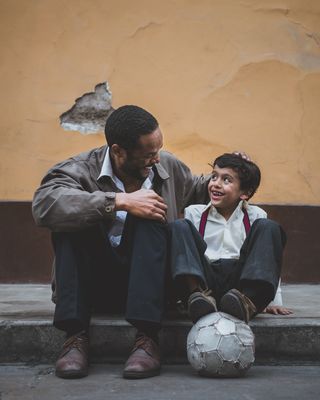Trauma
Restoring Rituals After a Potentially Traumatic Event
Re-establishing protective structures for your child.
Posted November 9, 2019
This is the third of a four-part series. Part 1 can be found here; Part 2 here; Part 4 here.
This installment focuses on the following caregiver intervention:
Maintain, restore, or increase structure
A potentially traumatic event (PTE) can undermine or overwhelm a child’s sense of general safety and well-being. Immediately after the event, caregivers can begin to seek out and work towards a return to normalization that does not deny, explicitly or implicitly, that the event took place or that it had an effect on the whole family.

As a rule, the sooner life returns to normal, the better. A return to recognizable routines can reassure a child that, no matter how disruptive the PTE was, “life” goes on.
When in doubt about whether it is too soon for a child to return to daycare, school, or other outside routines, the caregiver should evaluate the child’s ability to handle the daily activities of the home environment. Can the child return to a previous level of functioning at family meals? Are they able to perform the normal chores they were doing prior to the PTE? Is the child able to return to their regular eating and sleeping habits?
If the answer is “no” to one or more of these questions, the caregiver might be advised to put off for a day or two a return to a more challenging environment. For some children, however, school can be an easier place to function, and home can be more challenging. Such differences need to be considered, and seeking the child’s input may be helpful, so long as it is clear that the caregiver is making the decisions and that the child is not being expected to work this out or to know what to do.
Daily routines provide great contexts in which to enhance a child’s sense of security, safety, and predictability. A child who has been impacted by trauma usually needs additional reassurance and affection. Here are a few ways caregivers might supplement a child’s daily routines after a PTE:
- Add additional time to a bedtime routine and new expressions of love and support (e.g., gently rubbing the child’s back while reading a bedtime story)
- Make room in meal preparation for the child to participate by stirring ingredients in a bowl, pouring pre-measured seasoning or helping to set the table
- Provide the child with choices about what clothes to wear for the day or which pajamas to wear to bed.
Each of these provides an opportunity for the child to develop and practice competencies while bonding with the caregiver. Thoughtful planning, ensuring that options offered to the child are all acceptable to the caregiver, and choosing tasks that are not overly complex or challenging are ways to increase success with these strategies.
The new choices and activities offered to a child after a PTE should include the supportive participation of the caregiver. While learning to “do it yourself” is a valuable developmental lesson, within the post-trauma context, sending the child off to do things on their own may communicate to an already stressed-out child a withdrawal of caregiver support and piling on of new demands.
Competency increases one’s sense of control and personal safety. After a PTE, maximize the child’s opportunities to participate in activities they do well and enjoy. Placing the child into a protective cocoon is rarely warranted and is often more harmful than helpful.
On the other hand, warmth, affection, and support should always be present. Demonstrating authentic interest in the child’s experience and concerns is a powerful expression of love. That embracing affirmation is the context in which most children are able to heal.
When Juanita says she doesn’t want to go to school today, the supportive caregiver may respond with curiosity about Juanita’s feelings and concerns. The caregiver who is confident that this resistance to school is not overwhelming anxiety that will create a scene in the classroom may communicate to Juanita that she/he understands her feelings, but that skipping school today is not an option.
The conversation should not end there. The caregiver should help Juanita devise a plan, spelling out what she can do if things do not go well in school. Such a plan might include internal skills, such as mindful breathing or prayer, and more external approaches, such as speaking with a supportive adult at the school.
If the PTE occurred at a school, daycare facility, or any frequented location, the return to that place might be a source of anxiety. The level of anxiety may vary greatly based upon the child, the family, the location, and the presence of legitimate safety concerns. The possibility of working through anxiety and fears in order to enable a child’s successful return is both real and complex. Many children do return to a facility where trauma was experienced, and many do not.

In either case, the caregiver may be wise to include the following questions in the decision process:
- Is the facility/staff/organization responding with an appropriate level of seriousness and concern to the scary or harmful event that happened at their facility?
- Going forward, what accommodations are being offered to keep the child safe and help them feel supported?
- Should you decide to remove the child, will the disruption of their routine and the loss of supportive relationships be a significant loss for the child? For the caregivers? Would the advantages of the change outweigh the losses?
- What does your child want to do? What are their concerns about leaving their current school or daycare facility? What do they think about starting somewhere new? Speak with your child about the decision you are making to get their input, but reassure them that it is the caregivers who will decide what happens.
- What does your support network and professionals, who know your child and are aware of the PTE, think you should do? Consider the opinions of people who have knowledge of your child and your situation.
Remember that there is no way to know for certain what is best for a child and a family. All we can reasonably expect of ourselves is that we try our best to make the best and most loving decisions we can at that time.
This is the third entry of a four-part series. The final entry will focus on managing acting-out behaviors and on caregiver’s self-care.




